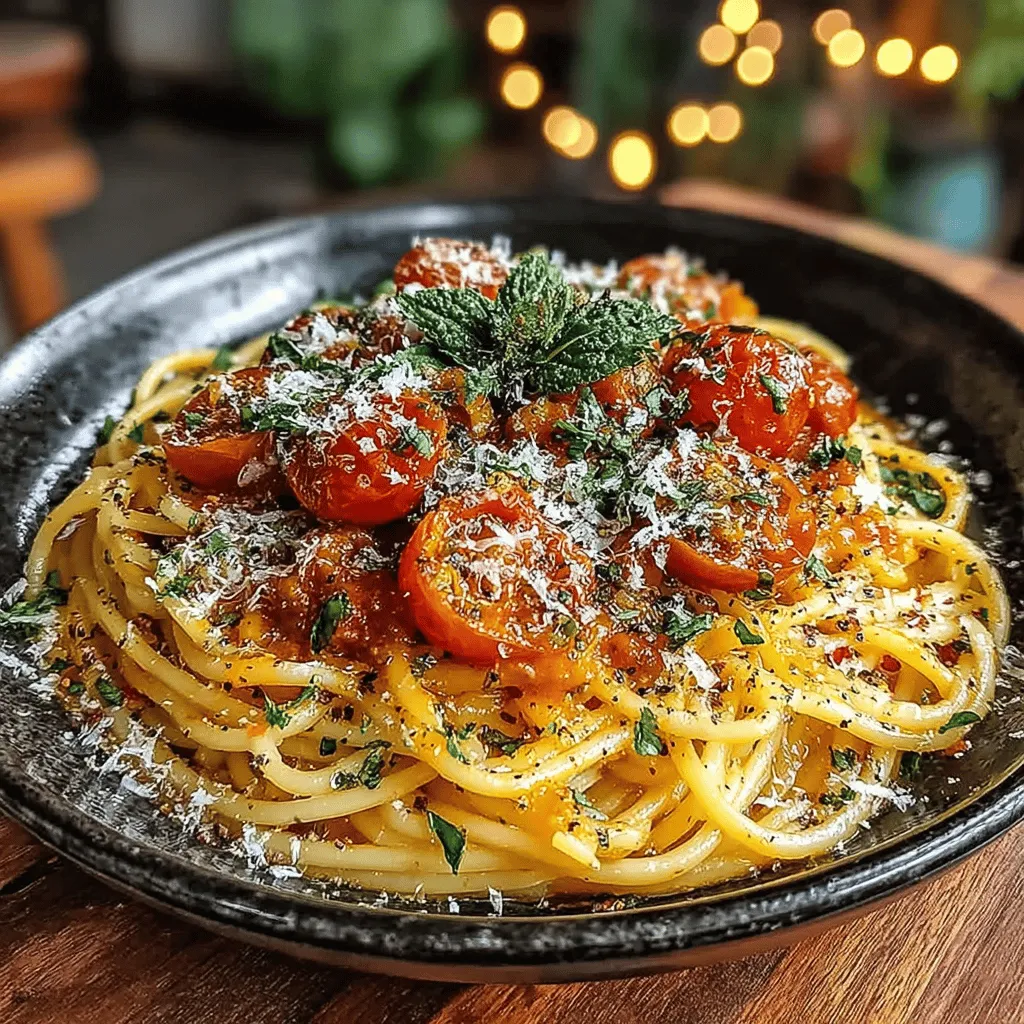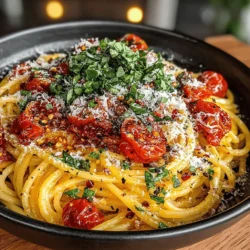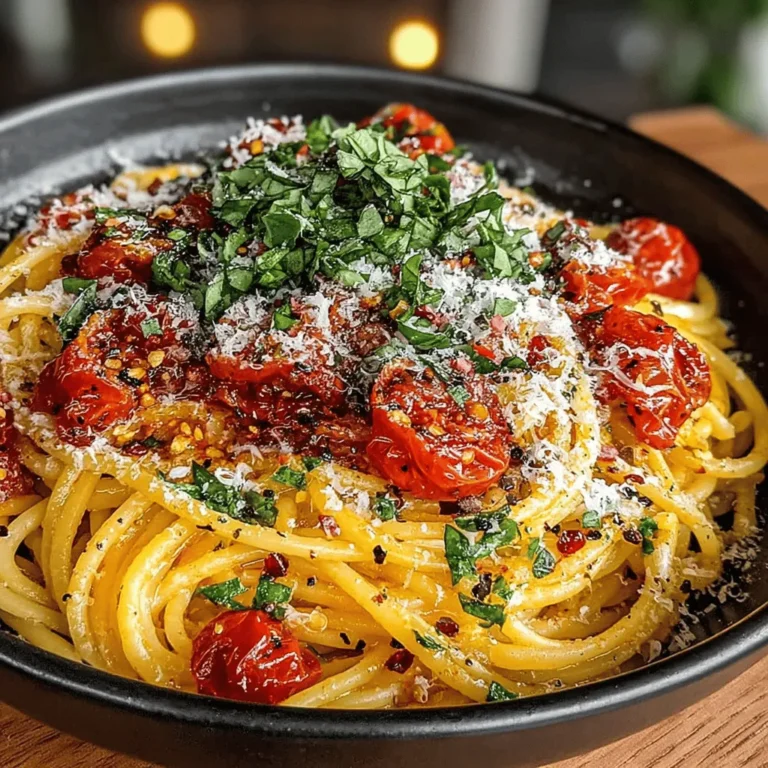Introduction to Fresh Tomato Basil Pasta
Fresh Tomato Basil Pasta is a delightful dish that embodies the essence of summer, celebrating the vibrant flavors of ripe tomatoes and fragrant basil. This simple yet elegant recipe has gained popularity for its ability to transform minimal ingredients into a flavorful experience that transports diners to sun-drenched Italian gardens. With its fresh and light appeal, it’s perfect for warm evenings on the patio or a quick weeknight meal when time is of the essence. Whether you’re serving it as a side dish or as a main course, this pasta dish is sure to impress family and friends.
The secret to achieving the best version of Fresh Tomato Basil Pasta lies in the use of high-quality, fresh ingredients. This dish highlights the natural sweetness of tomatoes, complemented by the aromatic qualities of basil, making it a perfect representation of the Mediterranean diet. By choosing fresh over canned ingredients, you elevate the dish, resulting in a meal that is not only delicious but also visually appealing.
Understanding the Ingredients
Fresh Produce: The Heart of the Dish
At the core of Fresh Tomato Basil Pasta are the tomatoes, and using heirloom varieties can make all the difference. Heirloom tomatoes, known for their unique shapes and vibrant colors, offer a rich and complex flavor profile that surpasses standard grocery store tomatoes. Their sweetness and juiciness create a luscious sauce that clings beautifully to the pasta, making every bite a burst of flavor. When selecting tomatoes, look for ones that feel heavy for their size and have a deep, rich color. These indicators often suggest ripeness and superior taste.
Fresh basil is another key ingredient that elevates this dish. Its bright, peppery notes bring a refreshing contrast to the sweetness of the tomatoes. The aroma released as you tear the leaves enhances the sensory experience, reminding you of summertime in Italy. To maximize flavor, consider using basil that is as fresh as possible, ideally from a local market or even your own garden.
Pantry Staples
While the fresh ingredients take center stage, a few pantry staples are essential for rounding out the flavors in this recipe. Garlic, olive oil, and red pepper flakes are the foundational components that bring depth and warmth to the dish. Garlic should be sautéed until golden, releasing its aromatic oils and infusing the pasta with a savory essence.
Extra virgin olive oil is the preferred choice for this recipe due to its robust flavor and health benefits. Not only does it add richness to the sauce, but it also offers heart-healthy fats that enhance the overall nutritional profile of the meal. When selecting olive oil, look for a high-quality brand that is cold-pressed, as this method preserves the oil’s flavor and nutritional content.
Red pepper flakes are optional but can provide a subtle heat that balances the sweetness of the tomatoes. A pinch can elevate the dish without overpowering the other flavors, making it an excellent addition for those who enjoy a little spice.
Cheese Selection
No Italian pasta dish would be complete without cheese, and for Fresh Tomato Basil Pasta, grated Parmesan cheese is the ideal choice. Parmesan adds a salty, nutty flavor that complements the fresh ingredients beautifully. Its richness helps to round out the dish, making each bite satisfying. When choosing Parmesan, opt for a block that you can grate fresh, as pre-grated varieties often contain anti-caking agents that can dull the flavor.
For those with dietary restrictions or preferences, there are several alternatives to Parmesan. Nutritional yeast can provide a similar umami flavor for vegans, while Pecorino Romano, a sheep’s milk cheese, can be used for a sharper taste. Additionally, vegan cheese options are increasingly available and can be used to replicate the creamy texture without dairy.
Step-by-Step Preparation
Cooking the Pasta to Perfection
The first step in preparing Fresh Tomato Basil Pasta is to cook the pasta to al dente perfection. This means cooking the pasta until it is firm to the bite, which allows it to hold its shape and texture when combined with the sauce. To achieve this, start by bringing a large pot of salted water to a rolling boil. The salt not only enhances the flavor of the pasta itself but also helps to season the dish from the inside out.
Once the water is boiling, add the pasta and cook according to the package instructions, typically around 8 to 10 minutes for most varieties. It’s crucial to taste the pasta a minute or two before the recommended cooking time to ensure it reaches the desired al dente consistency.
Another important tip is to reserve a cup of the pasta cooking water before draining. This starchy water is a valuable addition to the sauce, helping to create a velvety texture that clings to the pasta.
Sautéing Garlic: The Flavor Foundation
As the pasta cooks, it’s time to prepare the flavor base for the dish by sautéing garlic. In a large skillet, heat a generous amount of extra virgin olive oil over medium heat. Once the oil is shimmering, add minced garlic and sauté gently. It’s essential to monitor the heat carefully; garlic can burn easily, turning bitter and unpleasant. Aim for a golden hue, which typically takes around 1 to 2 minutes.
The sautéing process not only infuses the oil with garlic flavor but also sets the stage for the next step of creating the sauce. As the garlic cooks, it releases its savory aroma, filling your kitchen with an irresistible scent that promises a delicious meal ahead.
Creating the Tomato and Basil Sauce
Now it’s time to build the sauce that will envelop the pasta. To the skillet with the sautéed garlic, add the chopped heirloom tomatoes. The key to creating a rich sauce is allowing the tomatoes to soften and release their natural juices. Stir the tomatoes occasionally, letting them cook down for about 5 to 7 minutes. As they break down, their sweetness will intensify, creating a luscious sauce that pairs beautifully with the pasta.
Incorporate a handful of torn fresh basil leaves during the last few minutes of cooking. This will allow the herb’s flavor to infuse into the sauce without losing its vibrant color and aroma. If you enjoy a hint of heat, this is also the moment to sprinkle in some red pepper flakes, adjusting the quantity to suit your taste.
As the sauce simmers, the combination of garlic, tomatoes, and basil creates a symphony of flavors that epitomizes the freshness of this dish. The next steps will involve combining the pasta with the sauce, using the reserved pasta water to achieve the perfect consistency, but that will be the focus of the next section.
Stay tuned as we proceed to meld these wonderful ingredients together for a delicious finish!

Fresh Tomato Basil Pasta is a quintessential dish that celebrates the vibrant flavors of summer. This simple yet elegant recipe brings together the juiciness of ripe tomatoes, the aromatic essence of fresh basil, and the comforting texture of pasta. In the previous section, we explored the foundational elements of this dish, including ingredient selection and preparation. Now, let’s delve into the crucial steps for cooking, seasoning, and presenting your Fresh Tomato Basil Pasta, ensuring that every bite is a delightful experience.
Importance of Cooking Time for Basil to Retain Its Vibrant Flavor
One of the key aspects of creating a delicious Fresh Tomato Basil Pasta lies in how you handle the basil during the cooking process. Basil is delicate, and overcooking it can lead to a loss of its aromatic oils and vibrant flavor. The best practice is to add fresh basil towards the end of the cooking process, allowing it to wilt slightly without losing its essence. This ensures that you retain the bright, herby notes that basil brings to the dish while still allowing it to infuse its flavor into the sauce.
Combining Pasta with the Sauce
After cooking your pasta to al dente perfection, it’s time to bring everything together. Here are some best practices for tossing your pasta with the sauce:
– Tossing Method: Use a large mixing bowl or a deep skillet to combine the pasta and sauce. Start by adding the drained pasta to the skillet with the tomato sauce. It’s best to use tongs or a pasta fork for this task. This will help you gently toss the pasta, ensuring that each strand is evenly coated with the sauce.
– Adjusting Sauce Consistency: If the sauce appears too thick or sticky, this is where the reserved pasta water comes into play. Before draining your pasta, reserve about a cup of the starchy cooking water. Add a few tablespoons at a time to the pasta and sauce mixture until you achieve your desired consistency. This starchy water not only loosens the sauce but also helps it cling better to the pasta.
Final Touches and Presentation
Seasoning the Dish
Once your pasta and sauce are well combined, it’s time to fine-tune the flavors. Here are some essential tips for seasoning:
– Balancing Flavors: Start by adding salt and freshly cracked black pepper to your dish. These basic seasonings elevate the overall flavor profile. Depending on your taste preferences, you might consider a splash of balsamic vinegar for added depth. It adds a sweet acidity that can beautifully complement the tomatoes and basil.
– Tasting and Adjusting Seasoning: Always taste your dish before serving. This step is crucial to ensure that the flavors are balanced. If it tastes flat, a pinch more salt or a dash of acidity from lemon juice or balsamic vinegar can brighten the dish significantly.
Plating and Garnishing
The presentation of your Fresh Tomato Basil Pasta can enhance the dining experience. Here are some ideas for plating and garnishing:
– Visually Appealing Presentations: Use a large pasta bowl or individual plates to serve. Twirl the pasta into nests using a fork or tongs for a rustic yet elegant look. Drizzle a little more olive oil on top for a glossy finish.
– Suggestions for Additional Garnishes: Freshly grated Parmesan cheese or Pecorino Romano can add a rich, savory element to your dish. Consider adding a sprinkle of crushed red pepper flakes for a bit of heat or a few extra basil leaves for a pop of green. Lastly, a few cherry tomatoes halved and scattered on top can add color and freshness.
Nutritional Benefits of Fresh Tomato Basil Pasta
Health Benefits of Key Ingredients
The ingredients in your Fresh Tomato Basil Pasta not only contribute to its delicious flavor but also pack a nutritional punch:
– Nutritional Profile of Heirloom Tomatoes: Heirloom tomatoes are rich in vitamins A and C, antioxidants like lycopene, and dietary fiber. Lycopene is known for its potential heart health benefits and its role in reducing inflammation.
– Benefits of Basil: Fresh basil is not just a flavorful herb; it’s also loaded with vitamins (such as vitamin K) and antioxidants that support overall health. Basil has anti-inflammatory properties and may even help with digestion.
– Healthy Fats from Olive Oil: The olive oil used in the sauce provides heart-healthy monounsaturated fats, which can help lower bad cholesterol levels and reduce the risk of heart disease.
Portion Control and Serving Suggestions
When it comes to serving your Fresh Tomato Basil Pasta, consider the following:
– Ideal Serving Sizes: A typical serving size is about 2 ounces of dry pasta per person, which translates to roughly 1 to 1.5 cups of cooked pasta. Adjust this based on your guests’ appetites or if you are serving it as a main dish.
– Pairing Suggestions: To make your meal complete, consider pairing your pasta with a side salad or some crusty garlic bread. A simple arugula salad dressed with lemon vinaigrette can offer a refreshing contrast to the rich flavors of your pasta. For a heartier meal, roasted vegetables or grilled chicken can complement the dish beautifully.
Conclusion: Enjoying Fresh Tomato Basil Pasta
In summary, Fresh Tomato Basil Pasta exemplifies the beauty of simplicity in cooking. The combination of fresh, quality ingredients results in a dish that is not only delicious but also nourishing. By carefully managing the cooking time for basil, perfectly tossing your pasta with the sauce, and presenting your dish with thoughtful garnishes, you can create a memorable dining experience.
As you enjoy this delightful dish, don’t hesitate to experiment with seasonal ingredients. Swap out heirloom tomatoes for cherry tomatoes in the summer, or add sautéed zucchini and bell peppers for a veggie-packed version. The joy of cooking lies in creativity and improvisation, so feel free to make this recipe your own.
Ultimately, Fresh Tomato Basil Pasta is more than just a meal; it’s a celebration of fresh flavors and the joy of cooking. So gather your ingredients, invite some friends or family to join you, and enjoy the process of creating and savoring this delightful dish.


